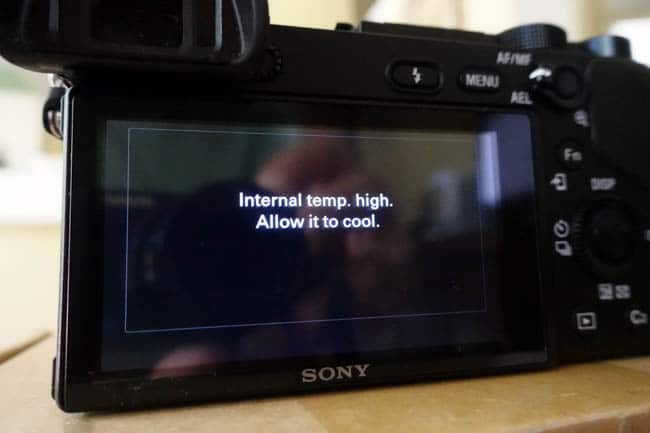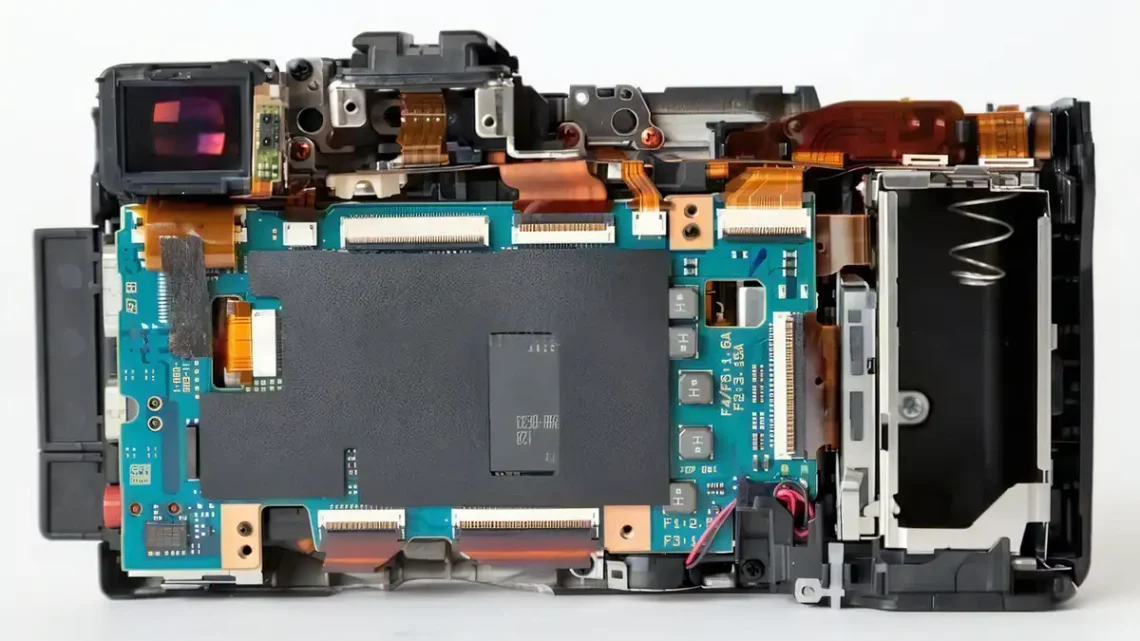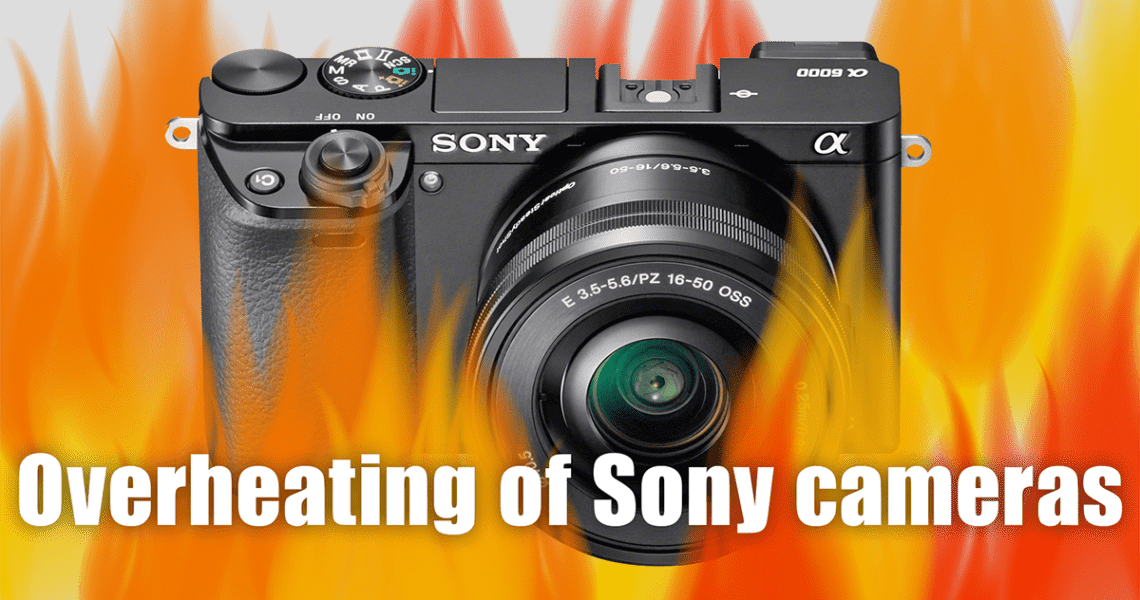Overheating of cameras Sony A6000, A6300, A6500, A7 while video recording
By Andrew LazarevOwners of APC-S Sony cameras such as A6000, A5100, NEX6, NEX7, A6300, A6500 when recording video encounter the problem of camera overheating.
Symptoms of the problem in all cameras are the same:
First, an overheat icon appears in the form of an orange thermometer. The icon can glow, blink, then disappear, then reappear.
After a while, the message “Camera overheated and will be turned off” appears. After that, after 10 seconds, the camera turns off spontaneously.

At what the second message appears suddenly, even when the thermometer icon has not appeared for a long time.
Where does this overheating come from?
Most often the term “matrix overheating” sounds. And “experts” frothing at the mouth say that matrix is large, the data from it when shooting video are read continuously and that is why the matrix overheats.
But let’s first think logically. The mirrorless camera is arranged so that the data from the matrix is read continuously as soon as you turn on the camera. Even if you do not take pictures at all and do not shoot the video. If you do a field shooting, either long or fast series, the camera never turns off on overheating, no matter how hot it was in the location where the photo report takes place.
So where is the matrix overheating? He is not here….
Now let’s look at how the matrix is fixed in the camera body.

The matrix is fixed by a fairly thick copper radiator on an aluminum chassis. Both copper and aluminum are the best conductors of heat and remove heat from the matrix. And the semiconductor matrix itself, like any inorganic semiconductor, works well at 90 degrees Celsius. In this case, the thermal noise will increase slightly, but nothing terrible will happen with the semiconductor.
So what is heating in this case? Where overheating comes from?
Now let’s look at the design of the “motherboard” mounting.

And what do we see? The matrix is fixed with a heat sink element but the camera controller’s board does not have a cooling system. The processor of the camera does not cool at all! Cameras, which prices at the start of sales began from 1000$, have a processor cooling system worse than in any Chinese smartphone for 60$ …
The processor is simply covered with an insulating film …
And this is a dead processor that is working at the limit of its capabilities. To make sure that the processor in the camera is dead, go to the web browser in the camera menu and see how everything slows down. That’s right, Sony, why to put in a camera for $ 1000 productive processor, people can use any…
But back to overheating. The processor is made on silicon logic, which, as noted above, perfectly maintains its performance even at 90 degrees Celsius. Have any of you burned your hands at least once holding the camera? No … the camera is just warm a bit when there is a spontaneous shutdown due to supposedly overheating.
If you watch videos on overheating of Sony cameras, you will see that “experts” and “craftsmen” offer a variety of ways to combat “overheating” during video shooting. Here are some of them:
- deflect the screen from the camera body,
- open the built-in flash,
- glue to the back cover of the housing copper radiator,
- use dummy (fake) battery – instead of the usual battery,
- fix the camera in a metal rig (frame),
- modification of the processor cooling system – instead of a black film covering the processor board, copper foil with an insulator from the electrocardboard is glued to the heat-conducting adhesive.
But for example, a video with a disassembly Sony A7S:
Oh, miracle! There is cooling of the processor! But the price tag of the camera is slightly different from the price tag of cameras with APS-C sensor…
I myself posted a video like this, where you can see that when using a dummy of a battery, the camera writes the video for two hours without overheating in the laboratory.
Turn on english subtitles on next video:
But in a real shooting environment, none of these methods saves. The camera still turns off spontaneously.
And some of the methods listed above lead to the opposite result.
Thus, deflecting the screen and raising the built-in flash results in increasing the thermal load on the camera body. Since air has a thermal conductivity much lower than the thermal conductivity of the material from which the screen unit is made, not to mention the metal built-in flash.
To glue a copper radiator is a dubious undertaking if you do not care about the price for which you will sell such a camera if necessary.
Fastening in a metal rig is a good option as is the use of lenses in a metal case, for example the SELP18105G lens.
Using a dummy battery is also a good option, even for cameras such as the A6300 and A6500 that can be powered by an external power source and via USB.
Also it is possible to ask for help wizards and fortunetellers.
But the camera went on turning off spontaneously for “overheating”. It still turns off in a non-laboratory real video shooting.
Now let’s remember two things.
- Heat capacity – objects do not instantly heat up and do not cool down instantly. Especially non-metals and semiconductors.
After the camera turns off for “overheating”, you can turn on the camera immediately and record the video further. And the camera for some reason does not turn off on “overheating” again…
Is it strange? …
More than. If the camera went to overheat for 40 minutes, it can not cool down instantly because the heat capacity of the materials of camera is not zero!
Sony A6500.
About a miracle! In the menu appeared “magic” item “Do not turn off the camera by overheating”. The user of the camera is of course cautioned that he does it at his own risk…
But how can it happen? If the fact of overheating takes place, the camera must not be switched off, otherwise it will break down. If there was no risk of damage to the technology in previous models of the camera, why was it so violently to force us to turn off the camera. They should have given at least a countdown … After all if the camera was going to overheat not less than 40 minutes, then for “5,4,3,2,1” nothing terrible would have happened with it…
Then what is this overheating such that the camera after recording continues to record video and does not turn off by “overheating” again?!
This kind of overheating is called MARKETING.
You have to buy the A6500 and the full-frame A7 (in different versions) or even better FS5, FS7 and further up the price list.
If the A6000 and similar cameras recorded video without any problems, who would spend money from 1500 USD to older cameras?
In a world where the words “heat conductivity” and “heat capacity” are rejected by the electorate at the subconscious level it becomes easier to make us fooled. Is it true, SONY? 😉
© 2017 Andrew Lazarev Production. Videography, photography, video editing in Kharkiv and the Kharkiv region, Ukraine. Blog about photography and videography.

great article I would’ve not thought about it being marketing related, really plosible thanks I was having doubts to buy the Sony a6400
a6400 doesn’t overheat – it has passive cooling interface.